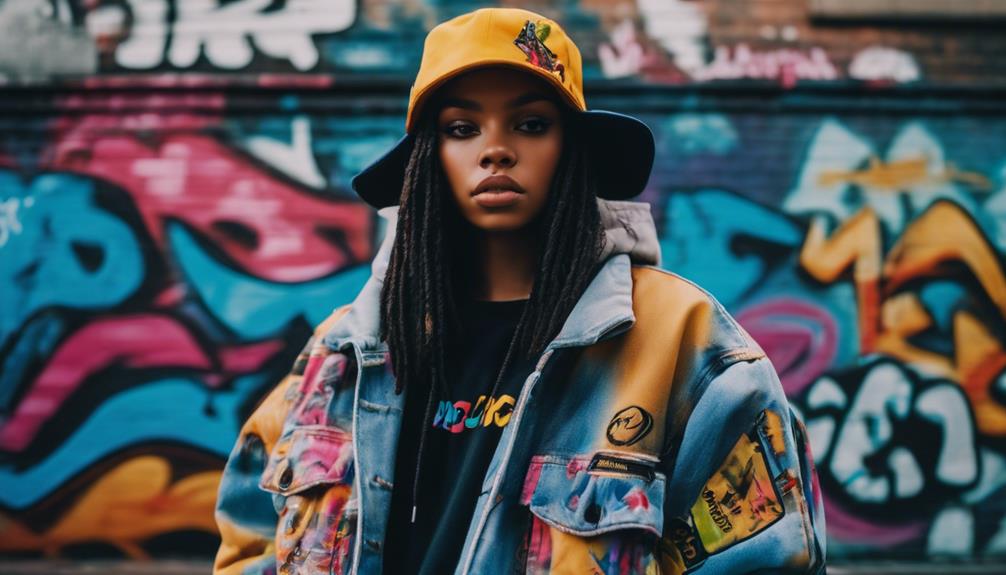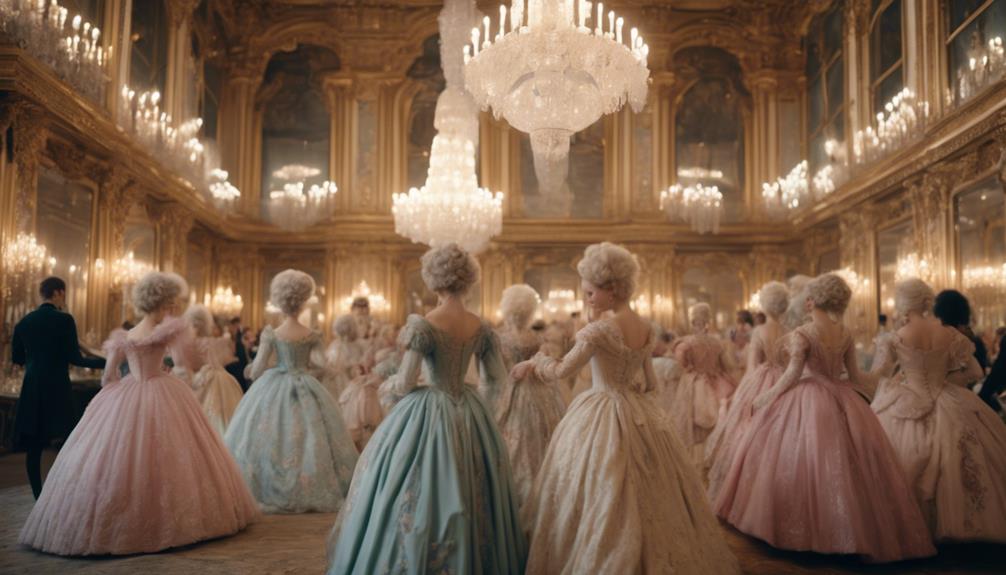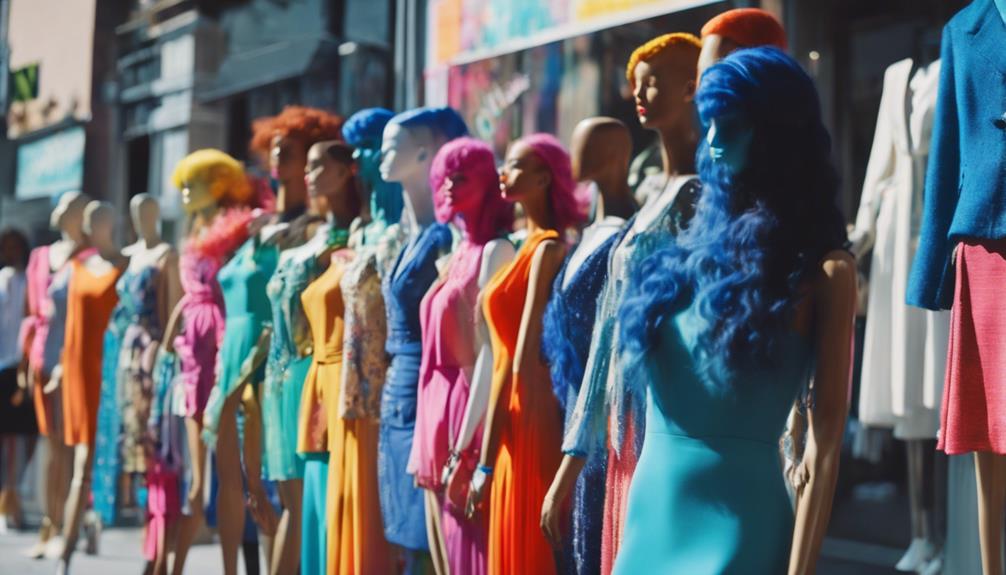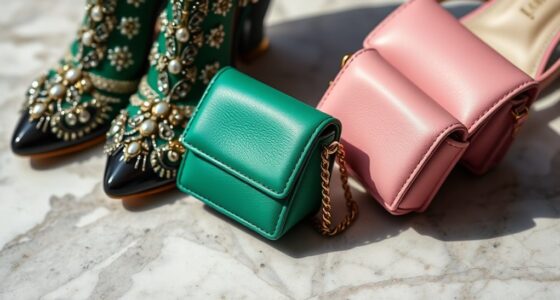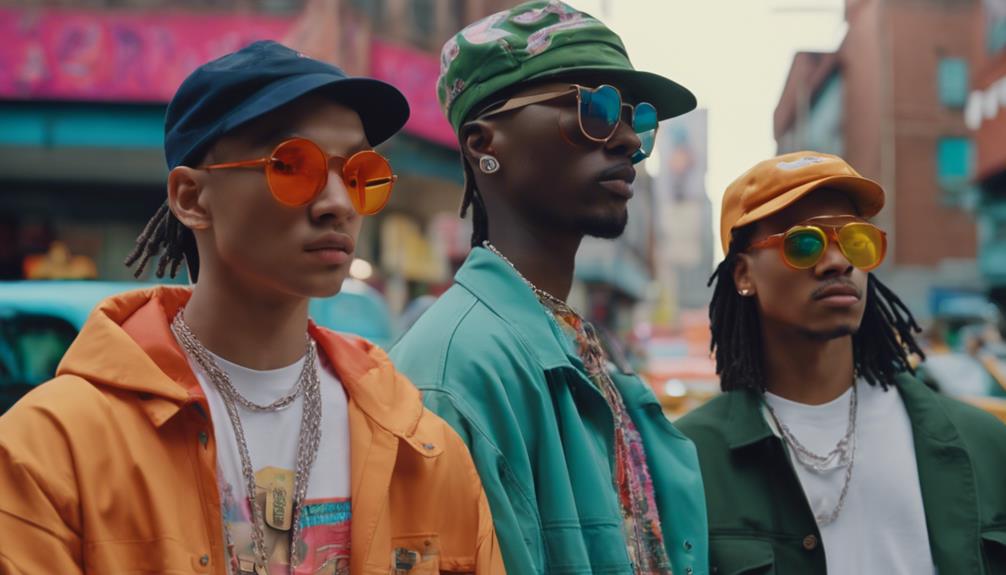The hip-hop fashion trend of the 2000s is centered around bold self-expression and oversized silhouettes. You will often find vibrant t-shirts paired with loose-fitting jeans and iconic tracksuits that embody a unique urban style. Consider combining high-end designer labels with streetwear such as FUBU or Sean John, creating the perfect fusion of luxury and casual wear. Accessories like gold chains and snapback caps are essential to enhance your overall look. Today, trendsetting artists are redefining this style, blending past influences with contemporary flair. Keep exploring to learn more about these iconic inspirations and how to master that timeless hip-hop aesthetic!
Key Takeaways
- The 2000s hip-hop fashion drew inspiration from the 1970s and 80s streetwear culture, emphasizing creativity and self-expression.
- Key characteristics included oversized silhouettes, vibrant colors, and staples like tracksuits, creating a bold street style.
- Influential artists like A$AP Rocky and Pharrell Williams modernized hip-hop fashion by blending luxury with streetwear aesthetics.
- Accessories such as gold chains and snapback caps were essential for achieving the iconic 2000s hip-hop vibe.
Origin and historical background of the fashion trend/style
When you look at the roots of 2000s hip-hop fashion, you'll see how streetwear culture took shape from the vibrant energy of the 1970s and 80s.
Breakdancing and graffiti art not only influenced music but also created a unique visual style that defined an era.
This blend of creativity and self-expression laid the groundwork for the bold trends that emerged in the new millennium.
Rise of Streetwear Culture
How did streetwear culture evolve from the resourcefulness of marginalized youth in the South Bronx during the 1970s into a dominant fashion movement that shaped hip-hop style?
Streetwear emerged as these young individuals creatively blended sportswear with urban aesthetics, establishing a unique street style that included oversized shirts, hoodies, and baggy pants. As hip-hop music gained traction in the 1980s, artists like Run-DMC and LL Cool J showcased this fashion in their music videos, further popularizing the trend.
Dapper Dan played a pivotal role in this evolution by merging luxury brands with streetwear. He created custom pieces featuring high-end logos, making luxury accessible to hip-hop artists and reshaping the fashion narrative.
By the late 1990s and into the 2000s, streetwear transformed into a mainstream phenomenon. Brands like FUBU and Sean John emerged, catering directly to hip-hop culture and reflecting its influence on contemporary fashion.
This shift marked a significant moment when streetwear became a powerful expression of identity and style within the hip-hop community, solidifying its status as a dominant force in the fashion world.
Breakdancing and Graffiti Art
Breakdancing and graffiti art emerged in the Bronx during the late 1970s, shaping a vibrant fashion style that emphasized comfort, mobility, and artistic expression. As breakdancing took center stage in hip hop culture, you'd notice B-boys and B-girls opting for baggy pants and oversized shirts. This choice not only allowed freedom of movement during intense dance battles but also made a bold statement about their identity and creativity.
Graffiti art played a vital role in this aesthetic, bringing colorful and intricate designs that often appeared on clothing and accessories. The bold visuals of graffiti complemented the street style of breakdancers, creating a unique blend of art and fashion.
Influential figures like DJ Kool Herc and Grandmaster Flash didn't just shape the music; they also inspired the culture surrounding breakdancing and graffiti, fostering a sense of community.
Together, breakdancing and graffiti art forged a distinctive street style that celebrated individuality and resourcefulness, laying the groundwork for hip hop fashion to evolve in the years to come. This fusion of movement and artistry remains an iconic part of hip hop history.
Key Characteristics
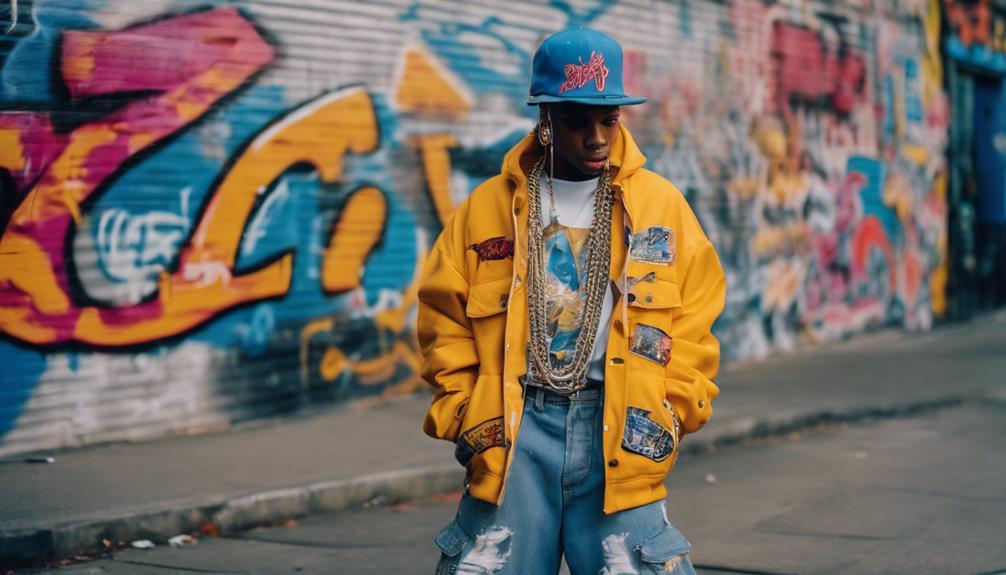
In the 2000s, hip hop fashion embraced bold, oversized silhouettes that made a statement.
You'd often see vibrant hues paired with classic denim and leather pieces, creating a dynamic look.
Tracksuits, especially those from Adidas, remained a staple, reflecting the genre's roots while evolving into a modern trend.
Bold, Oversized Silhouettes
Bold, oversized silhouettes dominate 2000s hip-hop fashion, reflecting a powerful blend of comfort, individuality, and defiance against mainstream style norms. You'll notice how baggy pants, oversized T-shirts, and loose-fitting jackets create a relaxed vibe that's both stylish and functional. This trend, deeply rooted in hip-hop culture, champions self-expression, allowing you to showcase your unique identity through your clothing choices.
Influential artists, like Run-DMC, popularized these bold looks, pairing tracksuits with large gold chains to represent a lifestyle that merged music and fashion. Streetwear brands like Cross Colours took this further, introducing vibrant colors and oversized denim that transformed the fashion landscape. The oversized silhouettes became a canvas for personal expression, especially for marginalized youth seeking to challenge societal norms.
As these styles gained traction, they began to seep into mainstream fashion, prompting high-end designers to incorporate similar aesthetics into their collections. You can see how this era not only defined a generation but also reshaped the way we view fashion, marking a significant shift towards a more inclusive and expressive approach to style.
Denim, Leather, and Vibrant Hues
Denim, leather, and vibrant hues became key characteristics of 2000s hip-hop fashion, amplifying the bold expressions of style that emerged from the previous decade.
You'll notice that denim remained a staple, with baggy jeans and oversized denim jackets still dominating the scene. This timeless fabric provided a canvas for individual expression, while its relaxed fit allowed for comfort and movement.
Leather, too, held its ground in hip-hop fashion, symbolizing toughness and street credibility. Artists like LL Cool J and The Notorious B.I.G. popularized leather jackets and pants, reinforcing an edgy aesthetic.
Vibrant hues burst onto the scene, with brands like Cross Colours paving the way for colorful designs that celebrated African-American culture and identity. You can't overlook the oversized clothing that became synonymous with this era, featuring colorful tracksuits and bold accessories.
These styles reflected a mix of cultural influences, drawing from African, Latino, and urban aesthetics. Ultimately, this vibrant combination of denim, leather, and bright colors gave you the freedom to express your individuality and confidence through your fashion choices.
Classic Adidas Tracksuits
Classic Adidas tracksuits, with their iconic three stripes, define a significant chapter in hip-hop fashion, blending comfort and style effortlessly. Originating in the 1980s, these tracksuits became emblematic of hip-hop culture, especially after groups like Run-DMC showcased them in their hit song 'My Adidas.' Constructed from lightweight polyester, they provided the perfect balance for breakdancing and casual wear, making them a staple in urban wardrobes.
You'll notice that these tracksuits often come in bold colors and oversized fits, reflecting the vibrant energy of street culture. This style allowed for self-expression among youth during the Golden Era of hip-hop, as they could mix and match with lace-less shell toe sneakers to create a complete look. The tracksuit's versatility made it more than just athletic wear; it became a fashion statement that represented a cultural shift.
The popularity of Adidas tracksuits sparked collaborations with hip-hop artists, further solidifying their role in both the music scene and fashion history. When you wear a classic Adidas tracksuit, you're not just sporting a piece of clothing; you're participating in a rich legacy of hip-hop culture and style.
Modern Interpretation
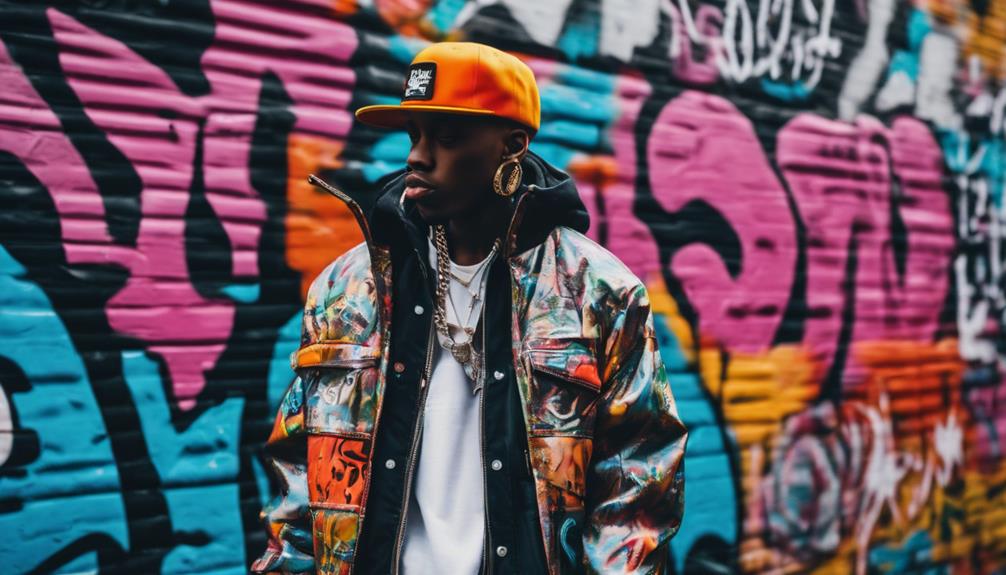
In 2023, streetwear's resurgence is impossible to ignore, blending nostalgic elements with fresh designs that reflect today's trends.
You'll see fashion-forward hip-hop artists setting the tone, showcasing their unique styles while honoring the icons of the past.
With influential streetwear icons leading the charge, modern interpretations of hip-hop fashion are more relevant than ever.
Streetwear's Resurgence in 2023
How has streetwear, with its vibrant nods to 80s and 90s hip-hop, captured the imagination of fashion enthusiasts in 2023?
This resurgence is all about oversized silhouettes and bold graphics that pay homage to the golden era of hip-hop fashion. You'll notice how contemporary styles draw from vintage-inspired looks that evoke nostalgia while remaining fresh and innovative.
Collaborations between artists like Cardi B and Reebok, as well as Beyoncé and Adidas, illustrate the fusion of streetwear with high fashion, making these pieces highly coveted.
Social media amplifies this trend, allowing fans to engage with the styles that resonate with them. As you scroll through feeds, you can see how influencers showcase their personal takes on streetwear, further driving consumer interest.
Moreover, sustainable fashion is becoming a priority, with brands opting for eco-friendly materials, blending style with environmental responsibility.
In 2023, streetwear is more than just clothing; it's a cultural statement that reflects the continued influence of hip-hop culture on modern aesthetics.
Streetwear Icons of 2023
Streetwear icons of 2023 are redefining style by merging bold aesthetics with personal flair, showcasing the vibrant evolution of hip-hop culture in fashion. This year, you'll notice artists like Tyler, the Creator and A$AP Rocky leading the charge, blending high fashion with casual streetwear elements. Oversized silhouettes and bold graphics dominate current trends, echoing 90s and early 2000s nostalgia while pushing creative boundaries.
Collaborations are a huge part of this scene. Cardi B's partnership with Reebok and Beyoncé's work with Adidas highlight how hip-hop fashion continues to influence mainstream styles. These collaborations not only elevate streetwear but also make it more accessible to a wider audience. Social media platforms like Instagram and TikTok amplify these trends, allowing you to see unique styles from influencers and artists around the world.
Another essential aspect of today's streetwear movement is sustainability. Many brands are now adopting eco-friendly practices and materials, catering to a growing demand for responsible fashion choices.
As you explore the current streetwear landscape, you'll see how these elements come together to create a dynamic, expressive, and stylish representation of hip-hop culture in 2023.
Fashion-Forward Hip-Hop Artists
Fashion-forward hip-hop artists are redefining style by seamlessly blending high fashion with their unique cultural influences, making bold statements that resonate with fans and the industry alike.
Artists like A$AP Rocky and Pharrell Williams showcase how hip-hop style can evolve, pairing tailored suits with luxury sneakers. Their iconic looks challenge traditional streetwear norms and elevate the genre into high fashion territory.
Cardi B's collaboration with Reebok highlights the power of fashion in promoting inclusivity, while Tyler, the Creator's Golf Wang brand merges skate culture with hip-hop aesthetics, emphasizing vibrant colors and challenging gender norms.
Kanye West's Yeezy line has revolutionized sneaker culture, often causing product sell-outs upon release, proving the immense impact of these artists on today's fashion landscape.
Rihanna's Fenty collaboration with Puma further exemplifies the intersection of high fashion and hip-hop culture, advocating for body positivity and empowerment through stylish designs.
These artists not only influence trends but also redefine what it means to be fashionable in the hip-hop community, paving the way for future generations to express themselves through innovative styles.
Styling Tips
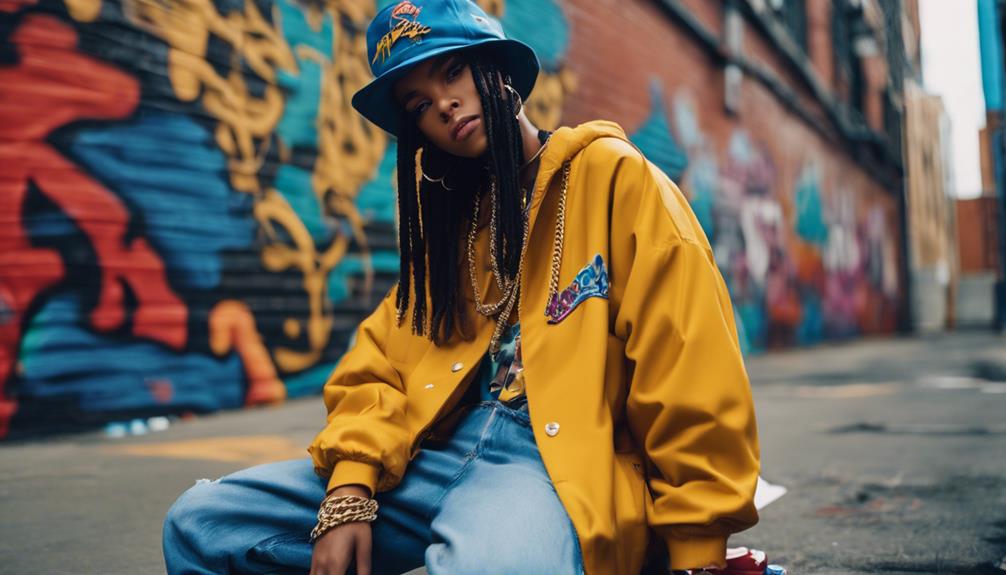
When it comes to nailing that 2000s hip hop vibe, you can't go wrong with statement tees and baggy jeans.
Mixing graphic tees with distressed denim adds an edgy touch, while layering different textures and patterns keeps your look fresh.
Let's break down some key styling tips to help you stand out in true hip-hop fashion.
Statement Tees and Baggy Jeans
To nail the look of 2000s hip-hop, pair a bold statement tee with baggy jeans for that effortless, laid-back vibe. Statement tees featuring eye-catching graphics or slogans not only showcase your personality but also pay homage to hip-hop culture. Opt for oversized fits to capture that quintessential streetwear aesthetic.
When it comes to baggy jeans, go for styles that offer comfort and a relaxed silhouette. Look for high-waisted options or those with a tapered leg to maintain a balanced look. Brands like FUBU and Cross Colours were pioneers in this space, so consider incorporating similar styles into your wardrobe.
To elevate your outfit, don't forget to accessorize! Layer oversized gold chains or throw on a classic baseball cap to enhance the overall vibe. These accessories are essential for rounding out your hip-hop-inspired ensemble.
Graphic Tees With Distressed Denim
Graphic tees paired with distressed denim create a laid-back yet edgy look that captures the essence of 2000s hip-hop style. To nail this look, go for oversized graphic tees featuring bold logos or iconic imagery. The relaxed fit not only pays homage to hip-hop roots but also adds a contemporary twist.
When selecting distressed denim, opt for baggy or loose cuts that exude comfort while showcasing that rugged vibe synonymous with the genre.
Accessorizing is key to complete your outfit. Chunky gold chains or statement necklaces elevate your look, adding a touch of glamour that contrasts with the casual elements. Don't forget a snapback cap to enhance the streetwear aesthetic—it's a classic choice that ties everything together.
For footwear, consider high-top sneakers or classic kicks to maintain that effortless vibe. Remember, confidence is essential when rocking this style, so wear what makes you feel good.
Mixing and matching different graphic tees and denim styles allows you to express your personality while staying true to the spirit of hip-hop fashion. Embrace the blend of comfort and edge, and you'll be turning heads in no time!
Layering Textures and Patterns
Layer textures and patterns to create dynamic outfits that reflect the bold spirit of 2000s hip-hop fashion.
Start with layering oversized shirts over graphic tees or sweatshirts, which instantly gives you that relaxed streetwear vibe. Don't shy away from mixing different textures; pairing a denim jacket with a cotton hoodie can add depth and interest to your look.
When it comes to patterns, think outside the box. Combine bold prints like plaid flannels with patterned T-shirts for an eye-catching appearance. This playful mixing not only showcases your style but also pays homage to the eclectic nature of hip-hop fashion.
Accessories are key in enhancing these layered outfits. Consider adding statement pieces such as gold chains, snapback hats, or even chunky sneakers to elevate your look.
Experiment with color combinations, like a bright hoodie under a neutral oversized jacket, to create a striking contrast that stays true to hip-hop's vibrant essence.
Shopping Guide
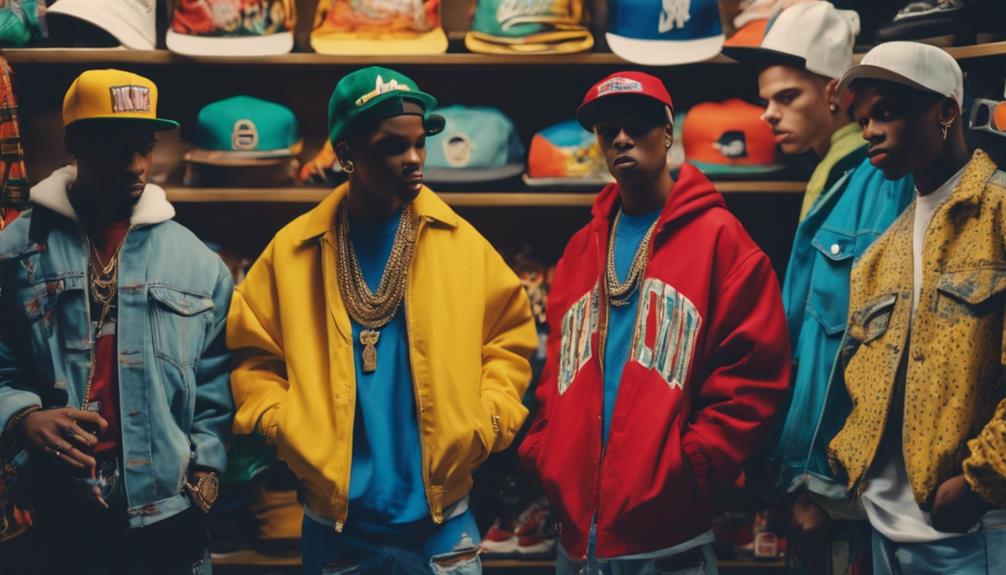
When you're ready to plunge into 2000s hip hop fashion, focus on finding key pieces that embody the bold and vibrant style of the era. Start by hunting down oversized graphic tees and baggy jeans, which are vital for nailing that laid-back vibe. Look for brands like FUBU, Cross Colours, and Karl Kani, as they were staples during the Golden Era.
Don't forget accessories; gold chains are a must-have to reflect the opulent flair of hip hop culture. Snapback caps and colorful bucket hats can elevate your look, giving you that iconic street style.
For footwear, vintage sneakers like the Adidas Superstar and Nike Air Force 1 are essential. They not only complete your ensemble but also pay homage to hip-hop legends who popularized these styles.
Explore thrift stores or online vintage shops for unique finds that capture the essence of 90s hip hop fashion. You might even discover contemporary collaborations, like the Adidas x Pharrell Williams collection, that offer modern twists on classic looks.
Happy shopping, and embrace the bold spirit of hip hop fashion!
Upcycled Streetwear Projects
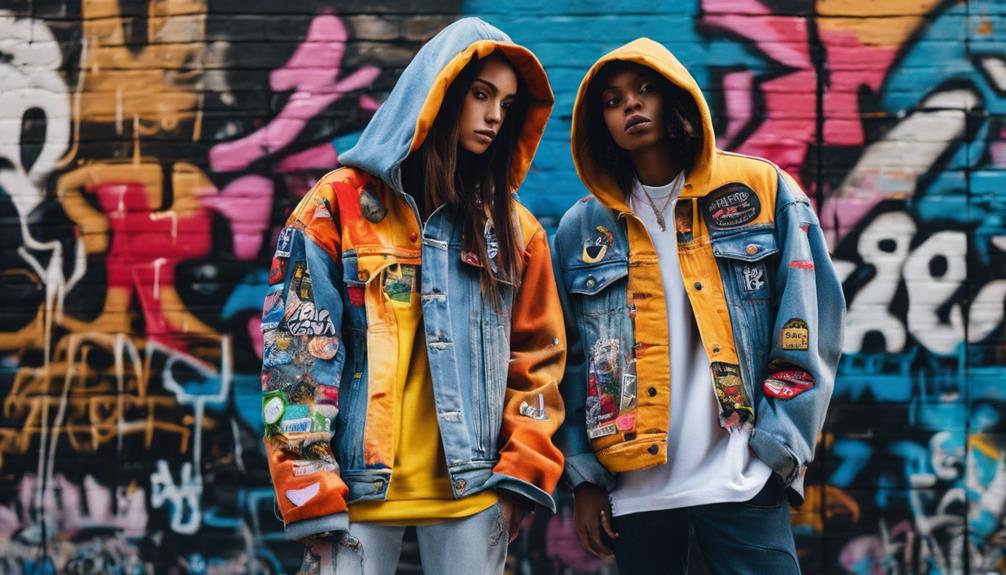
Upcycled streetwear projects are redefining style by turning discarded materials into fresh, unique pieces you can rock.
You'll notice how DIY patches and embroidery add a personal touch, honoring the resourcefulness of hip-hop culture.
This movement not only promotes sustainability but also empowers you to express your individuality through fashion.
Upcycled Fashion Projects
Revamping vintage clothing into fresh streetwear pieces not only reduces textile waste but also celebrates the vibrant styles of hip hop's golden era. Upcycled fashion projects are gaining traction as contemporary streetwear brands incorporate elements from the 80s and 90s hip hop scene. You'll find oversized tees and baggy jeans reimagined with bold graphics and vibrant colors that echo the lively spirit of that time.
These upcycled creations align perfectly with the growing emphasis on sustainability in the fashion industry. As consumers increasingly seek individuality and self-expression, upcycled streetwear offers a unique avenue for showcasing personal style.
Collaborations between established hip hop artists and emerging designers further enhance the cultural significance of these projects, promoting eco-friendly practices while honoring hip hop's roots.
The rise of thrift culture and DIY fashion initiatives is inspiring a new generation to engage in upcycled projects. This resourcefulness reflects the very essence of hip hop, reminding us that style can be both innovative and environmentally conscious.
DIY Patches and Embroidery
DIY patches and embroidery have emerged as a creative way for you to personalize your streetwear, turning everyday garments into unique expressions of style. This trend not only revitalizes old clothing but also allows you to showcase your personal style through custom designs.
Rooted in the 1980s and 1990s hip-hop culture, the practice of adding patches became a popular method to express individuality, especially among B-boys and graffiti artists. Upcycling through DIY methods is a sustainable approach that resonates with hip-hop's ethos of resourcefulness and self-expression.
By incorporating patches and embroidery, you breathe new life into your wardrobe, transforming simple pieces into trendy items that reflect your tastes. Many contemporary streetwear brands support this movement by offering DIY kits and tutorials, making it easier for you to partake in the fun.
Social media platforms further amplify this DIY culture, allowing you to share your upcycled projects and inspire others. As you immerse yourself in the world of DIY patches and embroidery, you not only embrace hip-hop fashion but also create a distinctive style that's all your own.
Cultural Impact
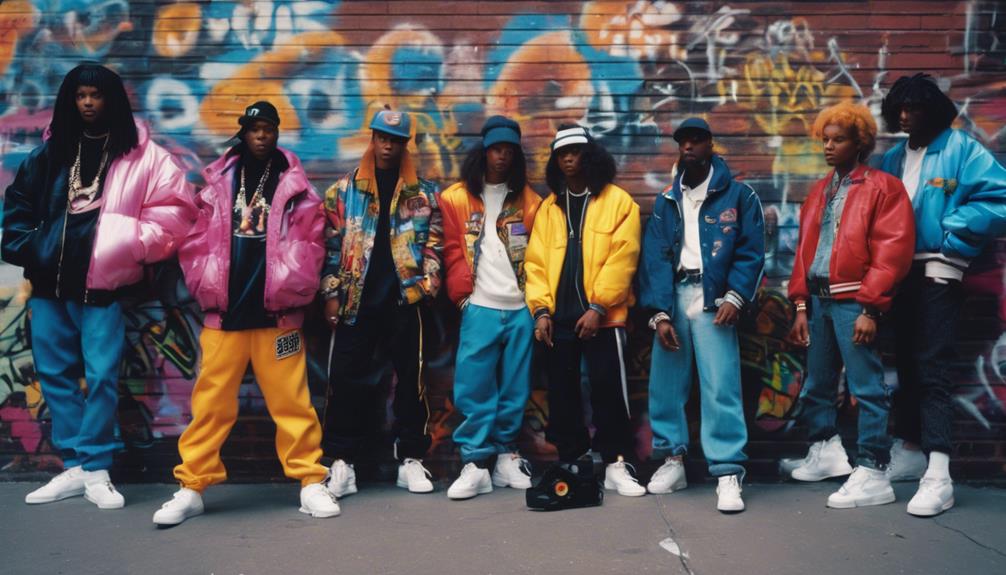
You can't overlook the influence of iconic music videos and films in shaping 2000s hip hop fashion.
These visual mediums not only showcased trends but also became platforms for artists to express social issues, especially during the Black Lives Matter protests.
This fusion of style and activism redefined what hip hop fashion represents in contemporary culture.
Iconic Music Videos and Films
Iconic music videos and films from the 2000s not only showcased innovative fashion but also shaped cultural perceptions and trends within the hip-hop community.
These visuals became a canvas for hip hop fashion, influencing how fans and artists expressed themselves. For instance, TLC's 'No Scrubs' video introduced oversized clothing and vibrant aesthetics that defined the 90s and lingered into the new millennium. Similarly, N.W.A's 'Straight Outta Compton' popularized the gangsta rap look, featuring baggy jeans and oversized shirts that reflected the gritty realities of urban life.
Films like 'Juice' starring Tupac Shakur captured the essence of streetwear, setting a standard for authenticity in hip-hop fashion. Missy Elliott's boundary-pushing visuals in 'The Rain (Supa Dupa Fly)' showcased not just style but also creativity, inspiring future generations to experiment with their looks.
These iconic music videos and films didn't just highlight clothing; they told stories, making hip-hop culture relatable and aspirational. Ultimately, they solidified the connection between music and fashion, leaving a lasting impact on how hip-hop is perceived today.
Black Lives Matter Protests
The Black Lives Matter protests, particularly those ignited by George Floyd's murder in 2020, became a powerful platform for hip hop artists to advocate for social justice and challenge systemic racism. You saw artists like Killer Mike and J. Cole take to the streets, using their voices and music to highlight the urgent need for change. Their involvement wasn't just about music; it was about creating a movement that resonated deeply with communities.
The fashion during these protests fused traditional hip hop aesthetics with strong activist messaging. Participants often donned streetwear brands that championed social justice and supported Black-owned businesses, emphasizing the importance of representation in the industry. This shift sparked crucial conversations about diversity within fashion, pushing many brands to rethink their collaborations.
In the wake of the protests, numerous fashion houses pledged their commitment to racial justice, intentionally incorporating Black culture and hip hop's influence into their campaigns. This intersection of hip hop and activism not only shaped the narrative around fashion but also amplified the call for equality, making it clear that style can be a powerful form of protest.
Frequently Asked Questions
What Is Considered the Golden Era of Hip Hop?
The Golden Era of hip hop typically spans from the mid-1980s to the mid-1990s. During this time, you'll find influential artists, diverse styles, and the mainstream acceptance of hip hop culture shaping music and fashion.
What Is the Traditional Clothing for Hip Hop?
Traditional hip hop clothing includes oversized shirts, baggy pants, and tracksuits, designed for comfort and movement. Sneakers, gold chains, and signature hats complete the look, reflecting your unique style and cultural identity within the genre.
What Are the Characteristics of Hip Hop Fashion?
Hip hop fashion's characterized by oversized clothing, bold colors, and graphic prints. You'll notice signature accessories like gold chains and sneakers from brands like Adidas, blending street style with luxury elements for a unique look.
What Is the Original Hip Hop Style?
The original hip hop style features oversized shirts, tracksuits, and sneakers, emphasizing comfort and functionality. You'll notice bold accessories like gold chains and Kangol hats, reflecting the vibrant street culture of the Bronx.
What Are the Similarities and Differences Between 80s and 2000s Hip Hop Fashion?
The iconic 80s hip hop fashion was characterized by bold colors, tracksuits, chunky jewelry, and Kangol hats. In the 2000s, hip hop fashion embraced baggy jeans, oversized jerseys, and bling. Both eras shared a love for sneakers and a rebellious attitude, but the style evolved with each decade.
Conclusion
To sum up, 2000s hip hop fashion isn't just a blast from the past; it's a vibrant part of today's style landscape.
By embracing its key characteristics and incorporating modern twists, you can create looks that pay homage to this iconic era.
Don't forget to explore upcycled projects to add a unique touch to your wardrobe.
So, go ahead, mix and match, and let the spirit of 2000s hip hop influence your personal style!
